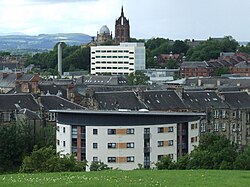Paisley Buddies
Paisley
|
|
|---|---|
 Paisley's skyline and backdrop from Saucel Hill, with the Thomas Coats Memorial Baptist Church in the centre |
|
| Paisley shown within Renfrewshire | |
| Population | 76,834 |
| OS grid reference | NS485635 |
| • Edinburgh | 49 mi (79 km) E |
| • London | 347 mi (558 km) SSE |
| Council area | |
| Lieutenancy area | |
| Country | Scotland |
| Sovereign state | United Kingdom |
| Post town | PAISLEY |
| Postcode district | PA1 – PA3 |
| Dialling code | 0141 & 01505 |
| Police | Scottish |
| Fire | Scottish |
| Ambulance | Scottish |
| EU Parliament | Scotland |
| UK Parliament | |
| Scottish Parliament | |
| Website | http://www.paisley.org.uk/ |
Paisley (/ˈpeɪzli/; Scottish Gaelic: Pàislig [ˈpʰaːʃʎikʲ]) is the largest town in the historic county of Renfrewshire in the west central Lowlands of Scotland and serves as the administrative centre for the Renfrewshire council area. The town is situated on the northern edge of the Gleniffer Braes, straddling the banks of the White Cart Water, a tributary of the River Clyde.
The town, a former burgh, forms part of the contiguous Greater Glasgow urban area; Glasgow city centre is 7 miles (11 km) to the east. The town came to prominence with the establishment of Paisley Abbey in the 12th century, an important religious hub which formerly had control over the other churches in the local area. It is often cited as "Scotland's largest town", as it does not have city status.
By the 19th century, Paisley had established itself as a centre of the weaving industry, giving its name to the Paisley shawl and the Paisley Pattern. The town's associations with political Radicalism were highlighted by its involvement in the Radical War of 1820, with striking weavers being instrumental in the protests. As of 1993, all of Paisley's mills had closed, although they are memorialised in the town's museums and civic history.
...
Wikipedia

